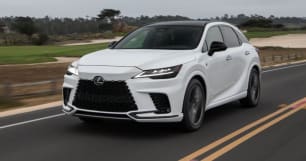With all of its features offering comfort and luxury, practicality is pretty high for the GV80 Coupe.
The cabin feels almost cavernous up front for my 168cm height. As mentioned, the seats are very comfortable and there is a stretching function that briefly comes on during a longer journey to ease any fatigue in your lumbar.
The rear row is almost as large as the front and there's a limo-like quality to the legroom that taller individuals will enjoy. The headroom is good for the outboard seats but a taller adult will be hunched when sat in the middle. Keep that for a kid!
Amenities in this row are excellent with the powered outboard seats that feature heat and cooling functions, directional air-vents, climate control and retractable sun-blinds (my son's favourites).
The individual storage is a little less than you might expect for such a large car, especially up front, as all options are on the shallow/small side.
There is a middle console (think of it as a tray), glove box, two cupholders, two drink bottle holders and a phone cubby that can be closed to keep things looking neat.
The rear row sees two map pockets, two cupholders and a storage cubby in the fold-down armrest, as well as some shallow bin storage.
Technology looks stellar, is easy to use and found throughout.
You're spoiled for choice when it comes to charging as there are four USB-C ports, three 12-volt sockets and a wireless charging pad to choose from.
And new for 2025 is the UV-C feature, which sterilises whatever you place inside the middle console. Handy for anyone who wants to disinfect small items, like a phone, keys or wallet.
The multimedia system takes a while to get used to as the tech has been updated but once you do, it’s an easy system. You can access the media system via the touchscreen or the rotary dial. Climate control and seat functions are accessed via the large control panel that sits underneath, which is handy for when you're on the go.
The GV80 Coupe has built-in sat nav, wired Apple CarPlay and Android Auto, as well as, a 12-inch colour head-up display.
Because of the sleek rear shape, the boot space sits at 644L when all seats are in use. It’s large enough for my gear and weekly errands and I like the powered tailgate's proximity feature. As long as you have the key fob, it will open when you stand at the rear. Great for when you have your hands full.
The loading space is level and the rear seat has a 40/20/40 split, which opens up storage options. But underneath the floor, there are heaps of cubbies for extra storage of smaller items and it’s here the tyre mobility and roadside assistance kits are housed.

